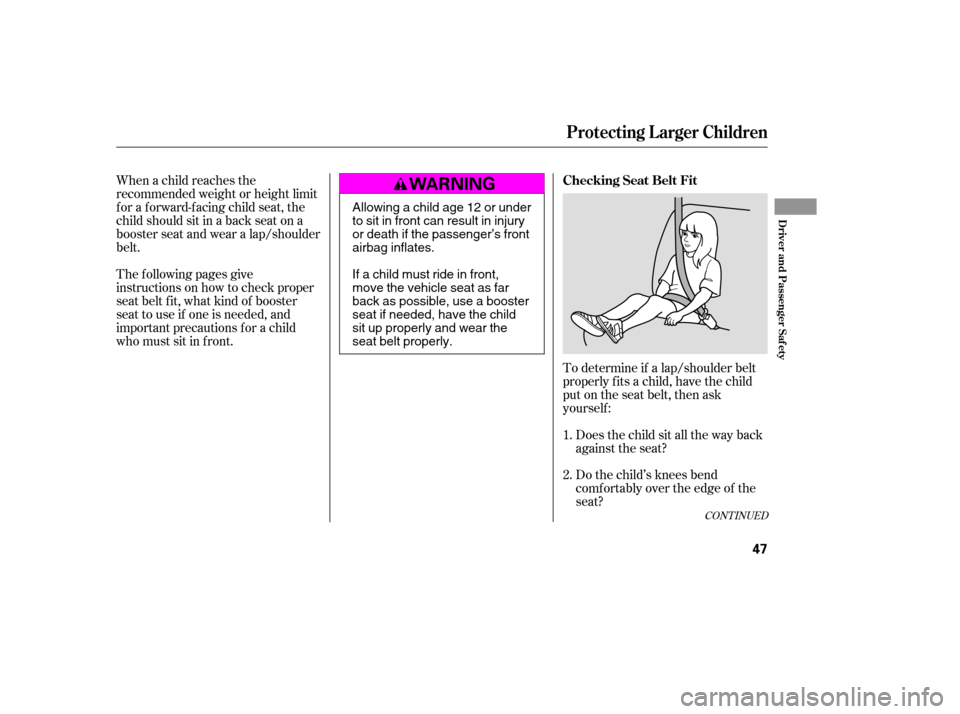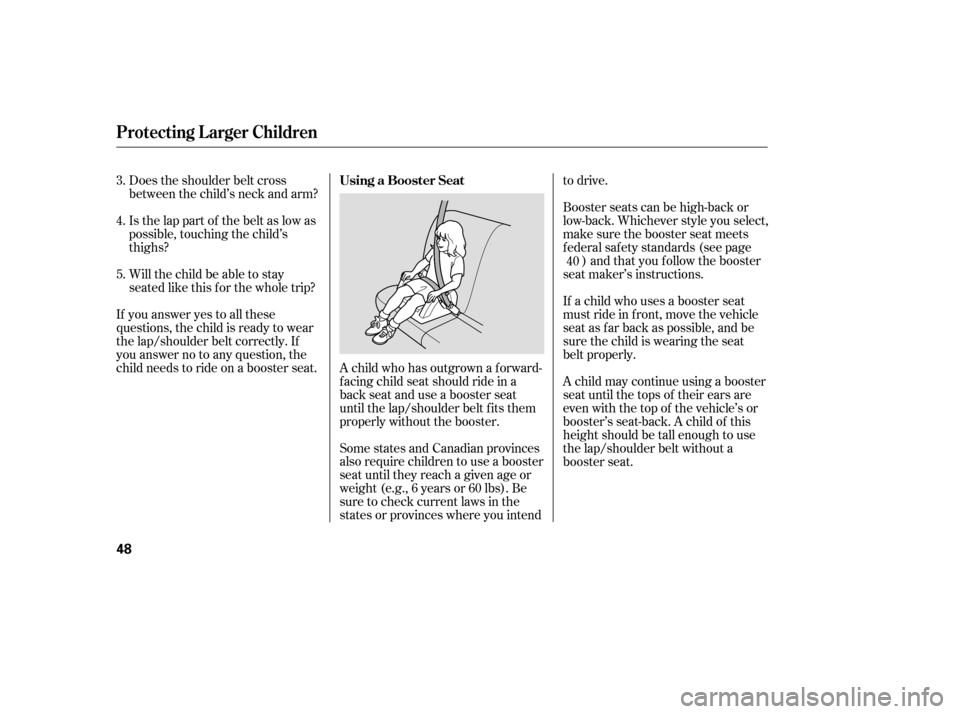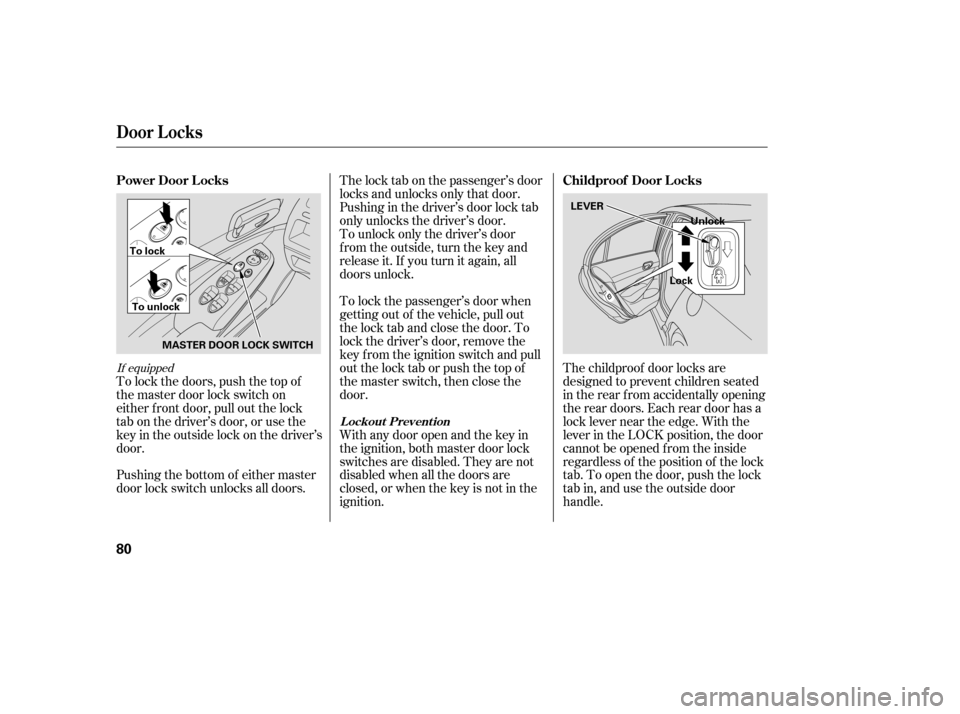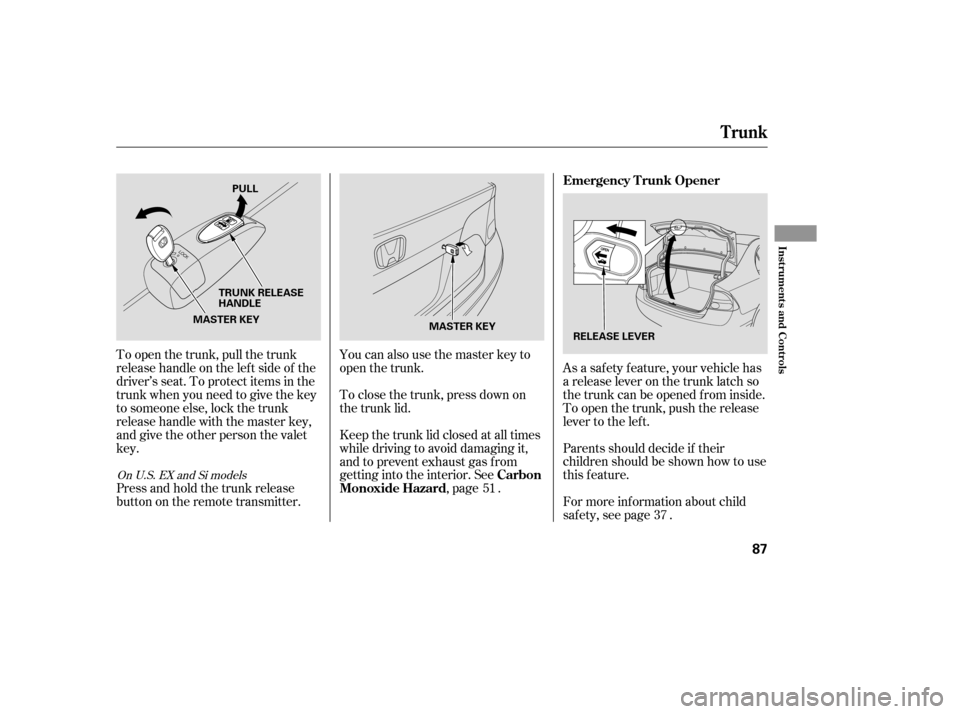Page 49 of 304

Af ter conf irming that the belt is
locked, grab the shoulder part of
the belt near the buckle, and pull
up to remove any slack from the
lap part of the belt. Remember, if
the lap part of the belt is not tight,
the child seat will not be secure.Push and pull the child seat
f orward and f rom side-to-side to
verif y that it is secure enough to
stay upright during normal driving
maneuvers. If the child seat is not
secure, unlatch the belt, allow it to
retract f ully, then repeat these
steps.
To remove slack, it may help to
putweightonthechildseat,or
push on the back of the seat while
pulling up on the belt. To deactivate the lockable retractor
and remove a child seat, unlatch the
buckle, unroute the seat belt, and let
the belt fully retract. Since a tether can provide additional
security to the lap/shoulder belt
installation, we recommend using a
tether whenever one is required or
available.
A child seat with a tether can be
installed in any seating position in
the back seat, using one of the
anchorage points shown above.
4.
5.
CONT INUED
Installing a Child Seat with a
Tether
Inst alling a Child Seat
Driver and Passenger Saf ety
45
COVER
ANCHORAGE POINTS
ANCHOR
�����—�����—�����y�����������
���y���
�(�#�����
���y���������y
Page 50 of 304
If the tether strap is too long and
cannot be tightened f irmly, f ind a
route where the strap can be
tightened securely.
Af ter properly securing the child
seat (see page ), lif t the head
restraint, then route the tether
strap over the seat-back and
through the head restraint legs.
Lift the anchor cover, then attach
the tether strap hook to the
anchor, making sure the strap is
not twisted.
Tighten the strap according to the
seat maker’s instructions.
1.
2.
3.
44
Inst alling a Child Seat
46
ANCHOR
ANCHOR
Outer Position TETHER
STRAP
HOOK
Center PositionTETHER
STRAP
HOOK
�����—�����—�����y���������������y���
�(�#�����
���y�������
�y
Page 51 of 304

To determine if a lap/shoulder belt
properly f its a child, have the child
put on the seat belt, then ask
yourself :Does the child sit all the way back
against the seat?
Do the child’s knees bend
comf ortably over the edge of the
seat?
When a child reaches the
recommended weight or height limit
for a forward-facing child seat, the
child should sit in a back seat on a
booster seat and wear a lap/shoulder
belt.
The f ollowing pages give
instructions on how to check proper
seat belt f it, what kind of booster
seat to use if one is needed, and
important precautions f or a child
who must sit in f ront.
1. 2.
CONT INUED
Checking Seat Belt Fit
Protecting L arger Children
Driver and Passenger Saf ety
47
Allowing a child age 12 or under
to sit in front can result in injury
or death if the passenger’s front
airbag inflates.
If a child must ride in front,
move the vehicle seat as far
back as possible, use a booster
seat if needed, have the child
sit up properly and wear the
seat belt properly.
�����—�����—�����y���������������y���
�(�#�����
���y���������y
Page 52 of 304

A child who has outgrown a forward-
f acing child seat should ride in a
back seat and use a booster seat
until the lap/shoulder belt f its them
properly without the booster.
Some states and Canadian provinces
also require children to use a booster
seat until they reach a given age or
weight (e.g., 6 years or 60 lbs). Be
sure to check current laws in the
states or provinces where you intendto drive.
Does the shoulder belt cross
between the child’s neck and arm?
Is the lap part of the belt as low as
possible, touching the child’s
thighs?
Will the child be able to stay
seated like this f or the whole trip?
If you answer yes to all these
questions, the child is ready to wear
the lap/shoulder belt correctly. If
you answer no to any question, the
child needs to ride on a booster seat. Booster seats can be high-back or
low-back. Whichever style you select,
make sure the booster seat meets
f ederal saf ety standards (see page
) and that you f ollow the booster
seat maker’s instructions.
If a child who uses a booster seat
must ride in f ront, move the vehicle
seat as far back as possible, and be
sure the child is wearing the seat
belt properly.
A child may continue using a booster
seat until the tops of their ears are
even with the top of the vehicle’s or
booster’s seat-back. A child of this
height should be tall enough to use
the lap/shoulder belt without a
booster seat.
3. 4. 5.
40
Using a Booster Seat
Protecting L arger Children
48
�����—�����—�����y���������������y���
�(�#�����
���y���������y
Page 53 of 304

The National Highway Traffic Safety
Administration and Transport
Canada recommend that all children
age 12 and under be properly
restrained in the back seat.
If the passenger’s front airbag
inf lates in a moderate to severe
f rontal collision, the airbag can cause
serious injuries to a child who is
unrestrained, improperly restrained,
sitting too close to the airbag, or out
of position.
A side airbag also poses risks. If any
part of a larger child’s body is in the
path of a deploying side airbag, the
child could receive possibly serious
injuries.Of course, children vary widely. And
while age may be one indicator of
when a child can saf ely ride in f ront,
there are other important f actors you
should consider.
If you decide that a child can saf ely
ride up f ront, be sure to:
Caref ully read the owner’s manual,
and make sure you understand all
seat belt instructions and all saf ety
inf ormation.
Move the vehicle seat to the rear-
most position.
Have the child sit up straight, back
against the seat, and feet on or
near the f loor.
Check that the child’s seat belt is
properly positioned and secured.
Supervise the child. Even mature
children sometimes need to be
reminded to f asten the seat belts
or sit properly.
Physically, a child must be large
enough f or the lap/shoulder belt to
properly f it (see pages and ). If
the seat belt does not f it properly,
with or without the child sitting on a
booster seat, the child should not sit
in f ront.
To saf ely ride in f ront, a child must
be able to f ollow the rules, including
sitting properly, and wearing the seat
belt properly throughout a ride.
14
47
When Can a L arger Child Sit in
Front
Physical Size
Maturity
Protecting L arger Children
Driver and Passenger Saf ety
49
�����—�����—�����y���������������y���
�(�#�����
���y���������y
Page 54 of 304
This could result
in serious neck injuries during a
crash. Devices intended to
improve a child’s comf ort or
reposition the shoulder part of a
seat belt can make the belt less
ef f ective and increase the chance
of serious injury in a crash.
This could
cause very serious injuries during
a crash. It also increases the
chance that the child will slide
under the belt in a crash and be
injured.
If they do, they
could be very seriously injured in a
crash.
Additional Saf ety Precautions
Do not let a child wear a seat belt
across t he neck. Do not put any accessories on a
seat belt.
Do not let a child put the shoulder part of a seat belt behind t he back or under t he arm.
T wo children should never use t hesame seat belt .
Protecting L arger Children
50
�����—�����—�����y���������������y���
�(�#�����
���y���������y
Page 83 of 304

To lock the passenger’s door when
getting out of the vehicle, pull out
the lock tab and close the door. To
lock the driver’s door, remove the
key f rom the ignition switch and pull
out the lock tab or push the top of
the master switch, then close the
door.
The lock tab on the passenger’s door
locks and unlocks only that door.
Pushing in the driver’s door lock tab
only unlocks the driver’s door.
To lock the doors, push the top of
the master door lock switch on
either f ront door, pull out the lock
tabonthedriver’sdoor,orusethe
keyintheoutsidelockonthedriver’s
door. To unlock only the driver’s door
f rom the outside, turn the key and
release it. If you turn it again, all
doors unlock.
With any door open and the key in
the ignition, both master door lock
switches are disabled. They are not
disabled when all the doors are
closed, or when the key is not in the
ignition.
Pushing the bottom of either master
door lock switch unlocks all doors. The childproof door locks are
designed to prevent children seated
in the rear f rom accidentally opening
the rear doors. Each rear door has a
lock lever near the edge. With the
lever in the LOCK position, the door
cannot be opened f rom the inside
regardless of the position of the lock
tab. To open the door, push the lock
tab in, and use the outside door
handle.
If equipped
Door L ocks
L ockout Prevent ion
Power Door L ocks
Childproof Door L ocks
80
MASTER DOOR LOCK SWITCH
To lock
To unlock LEVER
LockUnlock
�����—�����—�����y���������������y���
�(�#�����
���y���������y
Page 90 of 304

Parents should decide if their
children should be shown how to use
this feature.
As a saf ety f eature, your vehicle has
a release lever on the trunk latch so
the trunk can be opened f rom inside.
To open the trunk, push the release
lever to the lef t.
To open the trunk, pull the trunk
release handle on the lef t side of the
driver’s seat. To protect items in the
trunk when you need to give the key
to someone else, lock the trunk
release handle with the master key,
and give the other person the valetkey.
For more inf ormation about child
saf ety, see page .
Press and hold the trunk release
button on the remote transmitter. You can also use the master key to
open the trunk.
To close the trunk, press down on
the trunk lid.
Keep the trunk lid closed at all times
while driving to avoid damaging it,
and to prevent exhaust gas from
getting into the interior. See
,page .51
37
OnU.S.EXandSimodels
Emergency T runk Opener
Carbon
Monoxide Hazard
Trunk
Inst rument s and Cont rols
87
MASTER KEY
MASTER KEY PULL
TRUNK RELEASE
HANDLE RELEASE LEVER
�����—�����—�����y���������������y���
�(�#�����
���y���������y